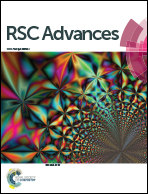Study of the effect of a novel high-performance gel polymer electrolyte based on thermoplastic polyurethane/poly(vinylidene fluoride)/polystyrene and formed using an electrospinning technique
Abstract
In this paper, nanofibrous membranes based on poly(vinylidene fluoride) (PVDF) doped with thermoplastic polyurethane (TPU) and polystyrene (PS) are prepared using an electrospinning technique and the corresponding composite gel polymer electrolytes (GPEs) are obtained after activation in liquid electrolyte. Their morphology characteristics and electrochemical performance are systematically investigated using scanning electron microscopy (SEM), a universal testing machine (UTM), thermal analysis (TGA), galvanostatic charge–discharge and electrochemical impedance spectroscopy. The GPE based on TPU/PVDF/PS shows a high ionic conductivity of 5.46 mS cm−1, an electrochemical stability window of 6.3 V, and a first discharge capacity of 169.5 mA h g−1 which is about 99.9% of the theoretical capacity of LiFePO4. The TPU/PVDF/PS films show a high tensile strength (12.8 ± 0.3 MPa) and elongation (99.4 ± 0.2%). With the help of excellent polyelectrolyte complexes, the prepared nanofibrous membranes present superior electrochemical and mechanical performances, which are very promising for application in polymer lithium ion batteries.


 Please wait while we load your content...
Please wait while we load your content...